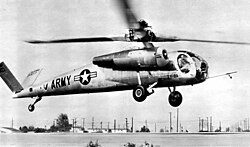Hughes XV-9
| Hughes XV-9 | |
|---|---|

|
|
| Type: | Blade tip propulsion experimental helicopter |
| Design country: | |
| Manufacturer: | |
| First flight: |
5th November 1964 |
| Number of pieces: |
1 |
The Hughes XV-9 (factory designation Model 385) was an experimental helicopter made by the American manufacturer Hughes Tool Company, Aircraft Division in the early 1960s. A blade tip drive system, which was new at the time and referred to by Hughes as hot-cycle drive, was used for the drive . The only prototype built received the military designation XV-9A and the USAF / Army serial number 64-15107.
history
Hughes designed, built, and flew the XV-9 based on a research contract with the US Army . The first stage of the development program in 1962 consisted of a 60-hour test run of the planned rotor construction. The entire drive part (turbines, fuselage boom and rotor) was then subjected to a 15-hour test run on the test bench in the spring of 1964 before the construction was installed in the fuselage.
The flight tests began in November 1964 and the first phase was completed after 15 hours of flight in February 1965. Further flight tests were carried out at Edwards Air Force Base . The flight tests were ended in August 1965 and the machine returned to Hughes.
construction
The propulsion took place via two General Electric YT64- GE-6 as gas generators , which were housed in nacelles on short raised booms on both sides of the fuselage. The hot exhaust gas flow was directed from the turbines to nozzles on the blade tips of the three-bladed rotor and to a nozzle at the stern for steering around the yaw axis . At the blade tips, the exhaust gas jet was diverted by 90 ° by cascade guide plates and accelerated to almost the speed of sound.
In order to keep costs down, existing components were used during the construction. The fully glazed cockpit came from a Hughes OH-6 A and the fixed landing gear from a Sikorsky CH-34 . The fuselage was a conventional half-shell construction made of an aluminum alloy. The control by means of the V-tail was supported in slow and VTOL flight by hot gas flows that could be ejected sideways on each side of the rudder. It was operated with the pilot's rudder pedals.
The three-bladed rotor was made of high-temperature steel (Rene 41) and had a constant depth of 0.80 m. The hot gases were routed between the two bars, cooling air was passed through the leading and trailing edges of the sheet and blown out at the nozzles.
Technical specifications
| Parameter | Data |
|---|---|
| crew | 2 side by side |
| length | 13.72 m |
| Rotor diameter | 16.76 m |
| height | 3.66 m (to the tip of the rotor head) |
| Empty mass | 3945 kg |
| Max. Takeoff mass | 6940 kg (overload case: 11,565 kg) |
| Top speed | 222 km / h |
| Range | 241 km |
| Engines | two General Electric YT64- GE-6 as gas generators with an output of 2125 kW each. Two fuel tanks with a total of 1890 l. |
See also
literature
- John WR Taylor (Ed.): Jane's All The World's Aircraft - 1965-66 , Sampson Low, Marston & Company Ltd., London, 1965
Web links
- Brief history at aviastar.org (accessed June 3, 2016, English)
- Hot Cycle Rotor Duct Closure Valve System. (PDF; 2.2 MB) Report No. 62-32. Hughes Tool Company, Aircraft Division, March 1963, accessed June 3, 2016 (Hughes Research Report on Blade Tip Outlet Design).